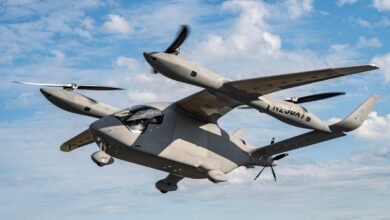The Middle East’s eVTOL Revolution: Leading the Future of Flight

▼ Summary
– Electric air taxis (eVTOLs) are nearing commercial reality, with the Middle East positioned to lead due to its supportive governments, strong demand, and ambitious vision.
– A recent report indicates that eVTOL fleets as small as 15 aircraft can operate economically at major airports, with two landing pads handling peak flows and turnaround times under 30 minutes.
– Key challenges for the eVTOL industry include building public trust, managing air traffic in dense areas, and ensuring regulatory readiness across aviation and non-aviation domains.
– The Middle East benefits from agile regulation, funding, and compelling demand from premium travelers and tourism, making it ideal for launching initial routes like airport-to-city transfers.
– Airports, airlines, real estate developers, and tourism operators can integrate eVTOLs to enhance services, boost property values, and strengthen regional economic growth.
The future of urban air mobility is arriving faster than many anticipated, and the Middle East stands at the forefront of this transformation. With visionary government initiatives, robust infrastructure investment, and a clear appetite for innovation, the region is uniquely positioned to pioneer the integration of electric vertical take-off and landing (eVTOL) aircraft into daily life.
Airports and major airlines have a significant opportunity to incorporate eVTOL services into their travel offerings, enhancing their competitive edge against other global hubs. These electric air taxis promise to redefine urban transport, offering a quieter, more sustainable, and increasingly affordable alternative to traditional helicopters and ground transit.
Recent analysis indicates that even modest eVTOL fleets, as small as 15 aircraft, can achieve economic sustainability when deployed at major airports. With just two compact landing pads, operators can manage peak passenger flows efficiently, maintaining turnaround times under thirty minutes. Once these services scale, their financial performance is expected to surpass that of helicopters, particularly on high-demand routes between airports and city centers where reduced noise is a major advantage.
Still, several hurdles remain before eVTOLs become a common sight in our skies. Public acceptance, air traffic control integration, and regulatory alignment represent critical challenges that must be addressed. Regulatory readiness spans not only aviation safety but also urban planning, noise ordinances, land use policies, and telecommunications frameworks.
The Middle East, however, is no stranger to ambitious technological leaps. Dubai has already committed to launching eVTOL services by 2026, and Saudi Arabia has embedded advanced mobility into its long-term urban development strategy. The region benefits from agile regulatory environments and substantial funding, unencumbered by legacy infrastructure that often slows progress in more mature markets.
Demand dynamics further strengthen the case for eVTOL adoption. The Middle East sees dense air traffic, especially in business and first-class segments, alongside strong tourist inflows and rapidly expanding urban centers. Key routes, such as from Dubai International Airport to the Marina district or from Riyadh’s King Khaled Airport to the King Abdullah Financial District, present ideal starting points for initial services.
Early adopters are likely to be premium travelers already willing to pay for convenience and speed. Initial fares may range between $250 and $350 per trip, but as operations scale and technology improves, prices are expected to fall significantly, making eVTOL travel accessible to a broader audience.
The potential applications extend well beyond airport transfers. Real estate developers can integrate vertiports into new projects, increasing property values and aligning with smart city objectives. Tourism and hospitality providers can offer aerial sightseeing and premium transfer services, elevating the region’s luxury appeal. Much like conventional aviation helped establish Dubai as a global hub, eVTOLs could drive the next phase of economic and technological leadership in the Middle East.
Realizing this vision requires decisive action today. Infrastructure planning should begin immediately, exploring options from rooftop vertiports to dedicated aerial mobility hubs. Collaboration among regulators, manufacturers, and operators is essential to establish safety protocols and seamless airspace integration. Equally important is building public trust through transparent communication around safety, affordability, and environmental benefits.
The world is watching to see which region will first successfully deploy eVTOLs at scale. With strong leadership, ample capital, and clear demand, the Middle East is well-equipped to lead this charge. By moving boldly, the region can not only address local transportation challenges but also export a successful model of advanced urban mobility to the rest of the world.
(Source: Economy Middle East)





